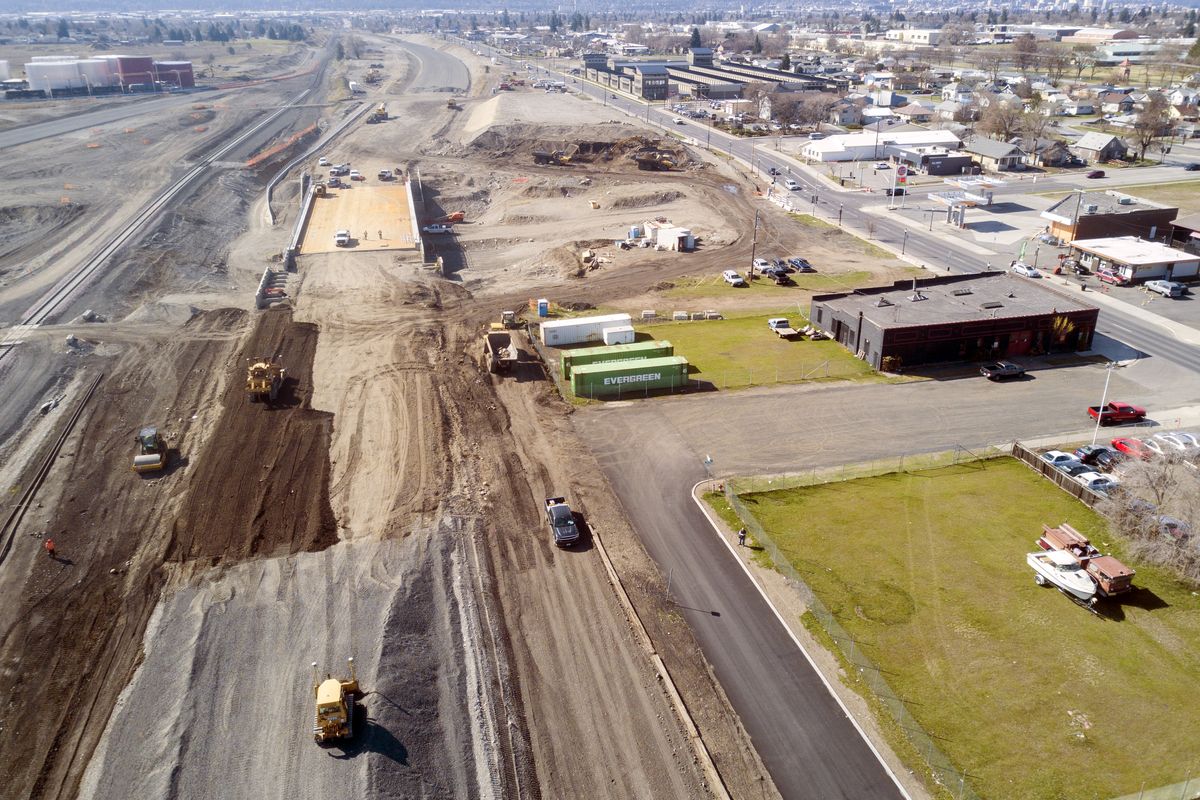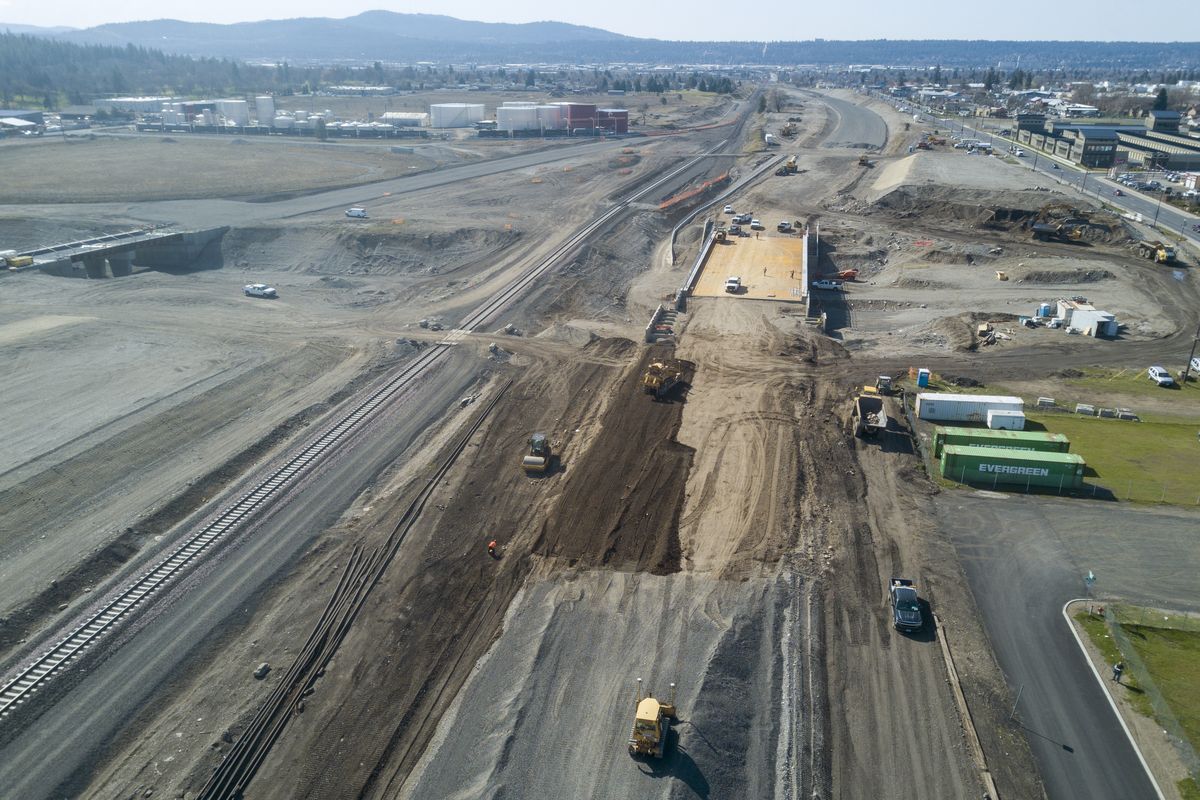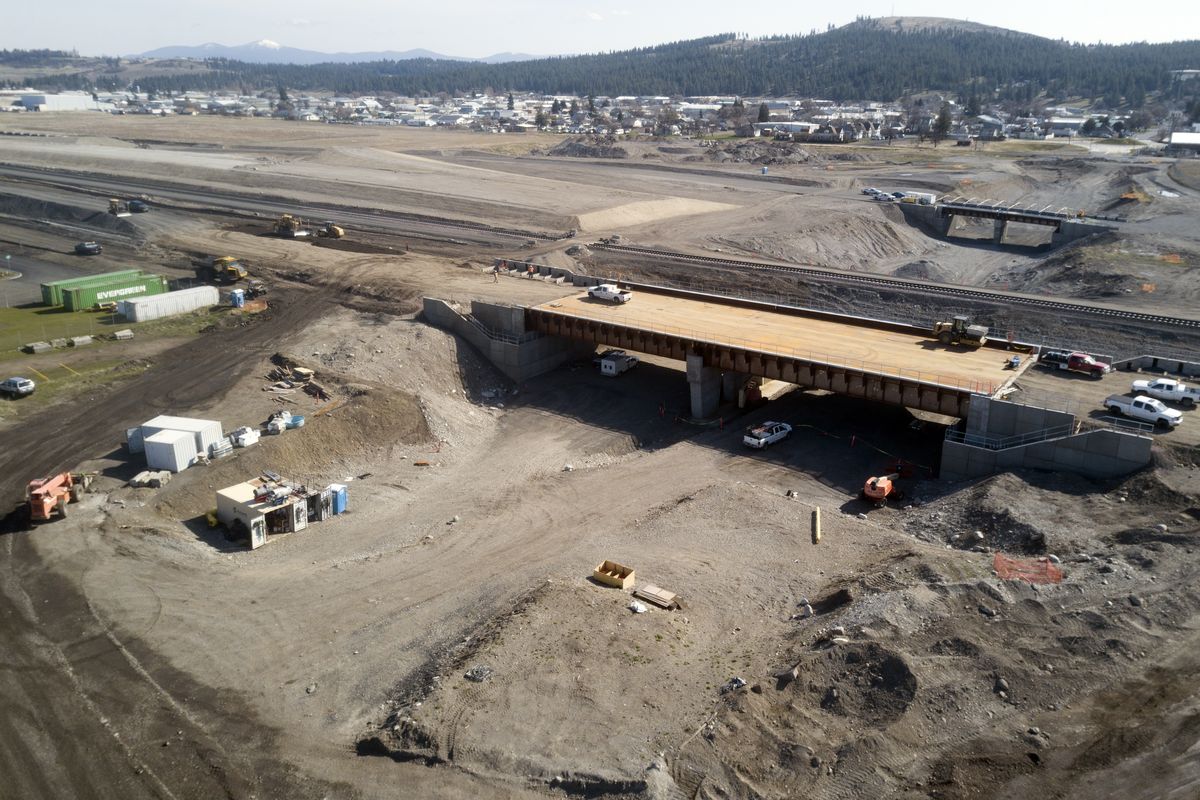Getting There: New legislative funds could accelerate North Spokane Corridor construction, but don’t get your hopes up
Construction is ongoing on the route of the North Spokane Corridor through Hillyard, shown Friday. The new corridor includes construction of multiple bridges over Wellesley Avenue, which closed through the construction of the realignment of the corridor, two rail tracks and Wellesley Avenue. (Jesse Tinsley/The Spokesman-Review)Buy a print of this photo
OLYMPIA – It may be difficult to imagine a world where there is no construction along the 10½-mile path of the North Spokane Corridor. After decades of discussion, the first project on the freeway broke ground in 2001, and it has been slow to finish.
The current end date for the project is 2029, but Spokane legislators are hoping for an acceleration of that timeline if new transportation funds pass in the state Legislature this year.
But don’t get your hopes up yet. There’s a lot it would take to get to that point.
Current completion timeline
The vision for the freeway started in the ’40s. It would give another route to travel north-south through the city, take major freight movement off Division Street and create a much more efficient way to travel through the area. After decades of conversations with the community, as well as environmental impact studies and funding discussions, the project is currently scheduled to be done by the end of this decade.
“The agency’s commitment is to finish the project,” said Mike Gribner, administrator for the Washington State Department of Transportation’s Eastern Region. “It’s a game-changing project.”
Right now, the specific goal is late 2029 for a fully operational corridor, but Gribner said there is still some uncertainty, especially after a year of paused projects and constraints caused by the COVID-19 pandemic.
The entire project costs about $1.49 billion and was fully funded in the 2015 Connecting Washington plan, which uses revenue from gas taxes. There were some concerns among Spokane legislators that with the pandemic keeping people off roads, the North Spokane Corridor would have to pause construction due to lack of funding.
No drivers buying gas means no revenue from gas taxes set aside for the project.

Luckily, with current proposed budgets, that doesn’t seem to be the case. Federal funding helped backfill a lot of the unexpected loss of revenue, so many projects can keep going. The next two-year plan projects $194 million for the North Spokane Corridor to continue construction.
“The Spokane legislative delegation has been on guard and been playing defense,” Spokane Democrat Sen. Andy Billig said. “The good news is that it looks like that will not happen despite revenue collections.”
Construction also slowed slightly during the COVID-19 pandemic.
WSDOT, like other government agencies, faced furloughs and a pause on construction projects about a year ago. When operations could continue, projects faced significant constraints to avoid spreading COVID-19. Social distancing meant fewer people on a site at once.
But all in all, the agency responded well, Gribner said. The costs could’ve been worse.
The completion date of the project might be affected slightly, he said, but not by much.
Expect construction from the Spokane River to Columbia Avenue to start later this month, and construction from Sprague Avenue to the Spokane River to start mid-May. Ongoing railroad realignment will continue, keeping the Wellesley interchange closed.
New funding to accelerate the project is possible
Spokane lawmakers have pushed to get funding to accelerate the project, and it could happen this year if a proposed transportation revenue package passes.
Democrats have been working on a transportation revenue package throughout the session, but senators complicated it slightly last week when they tied a new transportation package to two controversial climate change bills – part of what they dub a “grand bargain.” The grand bargain would tie any new spending on roads and highways to proposals that would reduce carbon emissions – a way to invest in new infrastructure while simultaneously cleaning the air, Billig said.
That package made some strides on Thursday, when the two climate bills, the “cap-and-trade” and clean fuel standards proposals, passed the Senate after a lengthy debate. Democrats and Gov. Jay Inslee have tried to pass both proposals for years.
The cap-and-trade bill would put a cap on greenhouse gas emissions and force companies that cannot meet that cap to purchase carbon allowances from the state. The clean fuel standards bill would reduce overall greenhouse gas emissions from transportation fuel 20% by 2035, according to the bill. To do so, the bill would incentivize the creation of alternative fuels in the state and penalize producers of transportation fuels that don’t meet the standards.
If both of those proposals reach final passage in the House, it may be more likely that a proposed transportation revenue package passes as well. The clean fuel standards bill already passed the House earlier this session, but legislators will need to review the amended version again. The cap-and-trade bill may face a tougher road.
Last week, the Senate Ways and Means Committee attached an amendment to the clean fuels standard bill that requires at least $500 million more every two years for transportation before the new standard could go into effect.
Currently in the Senate, there’s a $17.8 billion package floating around, which would use a 9.8-cent gas tax increase, revenue from cap-and-trade and other fees to fund new transportation projects.
Some of that funding could go toward accelerating construction on the North Spokane Corridor.
It is a possibility that if new investments in transportation come through, construction could be accelerated, Billig said. But construction does take time, so it’s unclear how much that timeline could move up.
Gribner said there are some risks associated with accelerating the project, and there’s always risk with a project that could slow it down.
The House’s version of a revenue package, which Spokane Rep. Marcus Riccelli worked on throughout the session, would also accelerate the timeline for the project. It would spend about $3 billion more but fund many of the same projects.
Riccelli said he was fairly confident it would be included in a final package.
Riccelli wants to see the plan accelerated by three years, which he says will save the state a little more than $7 million. That plan would require additional funding at first but would save money in the long run.
Without a new revenue package, it would require shifting money from other projects to the North Spokane Corridor. New revenue, however, could alleviate some of those issues, making it easier to speed up the project, Riccelli said.
He said seeing the project finished is the “No. 1 transportation priority for our region.”
When fully built, it will boost the local economy, reduce travel times and save an estimated 1.7 million gallons of gas annually, Riccelli wrote in an email.
“These improvements will help our farmers, manufacturers and other businesses thrive by making it easier and cheaper to get their goods to market,” he said.
Pushing the timeline up could shorten the construction time, reduce the overall cost and pollution, and allow people to begin using it sooner, Riccelli said.
A new transportation package has other money for Spokane, including $50 million over the next 16 years for the Division Street Rapid Bus Transit line. The project has already started its predesign phase but is awaiting further funding before construction can begin.
The new bus line is part of the overall vision for Division Street, which would set aside part of the street for electric rapid-transit buses to turn it into a more public-transit-focused corridor.
More funding in the proposed package could also mean new investments at the airport, and bike and pedestrian projects.
The Senate and House packages differ slightly, mostly in the amount they spend, with the House spending slightly more.
The Senate plan also relies on the cap-and-trade program, which might not have as much support in the House. On the other hand, the House plan uses a carbon tax to make up for that revenue.
It’s unclear at this point how the two proposals might be reconciled to get final passage on a package this session.
It doesn’t mean legislators won’t try until the very last second to get a transportation revenue package through. The legislative session ends April 25.
“It’s a tall order with just a little over two weeks left,” Billig said. “We’re going to give it our best effort.”






